In 1527, The Spanish soldier Pánfilio de Narváez, with a reputation for brutality and a strong desire to find gold and wealth, began his ill-fated invasion of Florida. Failing to find the mythical gold and militarily defeated by the Indians, the surviving Spanish built five boats with the intention of sailing from the panhandle of Florida to Mexico. They made it to Galveston Island in Texas where the four survivors– Narváez, Alvar Núnez Cabeza de Vaca, Andrés Dorantes, and a black slave Esteván (also called Estévanico and Esteban)—lived in a state of semi-slavery among the Karankawa. In 1536, they managed to escape and return to Mexico City. Among the many tales they told of their adventures were their reports of seeing the Indians from diverse tribes talking to each other with their hands. This is one of the earliest European reports of an American Indian signed language.
In 1541-1542, the Spanish explorer Francisco Vásquez de Coronado led an expedition through the Southwest and into the Great Plains. Once again, the Spanish chroniclers report that Indians from diverse tribes, speaking different languages, were able to communicate fluently with each other using a signed language.
During the 18th and 19th centuries, the American Indian horse culture flourished on the Great Plains and the number of culturally and linguistically diverse groups increased. In addition, there was a flood of American explorers, such as Meriwether Lewis and William Clark, fur traders, and missionaries who found that the signed language of the Great Plains was indispensable. Today this language is known as the Plains Indian Sign Language (PISL).
By the nineteenth century Plains Indian Sign Language was used by tribes which spoke more than three dozen languages. Not every individual in the tribe was fluent in sign and there was great variation between the tribes regarding fluency in sign. Some individuals had a vocabulary of 3,500 words while most functioned quite well with a vocabulary of 500 to 1,000 words in sign.
While there are many signed languages, and the users of these languages are sometimes call sign-talkers, the Plains Indian Sign Language stands out as being one of the best documented. In his 1918 book Sign Talk of the Cheyenne Indians and Other Cultures, Ernest Seton writes:
“But the American Plains Indian is undoubtedly the best sign-talker the world knows to-day. There are, or were, some thirty different tribes with a peculiar speech of their own, and each of these communicated with the others by the use of the simple and convenient sign-talk of the plains.”
What is the Plains Indian Sign Language?
Let us begin with what Plains Indian Sign Language is not: it is not a form of pantomime which uses iconic signs which are easily recognizable by those unfamiliar with it. Plains Indian Sign Language is one of about 200 signed languages which linguists recognize as fully developed languages. Like other signed languages, it is not based on any spoken language.
In his book Through Indian Sign Language: The Fort Sill Ledgers of Hugh Lenox Scott and Iseeo 1889-1897, William Meadows writes:
“Plains Indian Sign Language is the most sophisticated of all known North American nonspeech communication systems. It consists of an extensive vocabulary of physical and body signs and movements to signify individual words, phrases and concepts. Sign language is a communication system independent of spoken language and thus not an alternative system of expression, such as the relationship between a spoken language and its written form.”
In his chapter on nonspeech communications systems in the Handbook of North American Indians, Allan Taylor writes:
“The sign language is not a secondary system based on a particular language or languages, but an independently structured primary system for communicating ideas directly.”
How was Plains Indian Sign Language Used?
Plains Indian Sign Language is best known for its use in intertribal communications. During the eighteenth and nineteenth centuries, the number of tribes on the Plains increased as did the linguistic diversity. This diversity, coupled with increased trade driven partially by the European markets, enhanced the importance of Plains Indian Sign Language as a lingua franca in the region. Allan Taylor writes:
“Trade may have been an important stimulus in the development of the sign language, and it was certainly an important factor in its diffusion after the rise of Plains horse nomadism.”
Like other signed languages, Plains Indian Sign Language was the primary language of the Deaf communities among the Plains Indian nations. Allan Taylor writes:
“It is likely that deaf people have always used the sign language, a use that continued on the Plains reservations in the late twentieth century.”
Plains Indian Sign Language was also used when there was a need for silence, particularly when hunting or on raiding parties. In addition to being silent, the sign-talkers could talk to each other at some distance.
During the reservation era and into the twentieth and twenty-first centuries, a number of traditional story-tellers signed the stories while telling them in either their native language or in English. This practice has led some people to view the Plains Indian Sign Language as subordinate to the spoken language.
In 1930, a major council of sign-talkers was held at Browning, Montana on the Blackfeet Indian Reservation to create a permanent film record of the Plains Indian Sign Language which was believed to be near extinction. With regard to the use of the signed language, Jeffrey Davis, in his book Hand Talk: Sign Language among American Indian Nations, reports:
“During the three-day Indian Sign Language Council, the participants discussed a variety of topics and shared several anecdotes, stories, and discourse genres, all of which were documented in these films.”
Plains Indian Sign Language is currently an endangered language. Jeffrey Davis writes:
“It is still used within some native groups in traditional storytelling, rituals, legends, prayers, and conversational narratives, and by American Indians who are deaf.”
Were there other American Indian Sign Languages?
While most of the linguistic study of Indian sign language has focused on the Plains tribes, there are some suggestions that sign languages also developed independently in other areas. In his book Hand Talk: Sign Language among American Indian Nations, Jeffrey Davis writes:
“Although sign language was evidently used across the major North American Indian cultural areas, the best-documented cases involved members of the Great Plains Indian cultural groups and the native groups bordering the Great Plains geographic area.”
The Plateau Culture Area—the area between the Rocky Mountains and the Cascade mountains that includes western Montana, northern Idaho, eastern Washington, northeastern Oregon, and southeastern British Columbia—appears to have developed its own distinctive sign language prior to the adoption of the horse. Once the Indian nations of the eastern portion of this area had the horse, they began hunting buffalo on the Great Plains, putting them into contact with the Plains tribes. At this time, they seem to have adopted the Plains sign language which eventually replaced the Plateau sign language.
With regard to the diffusion of the Plains Indian Sign Language from the Plains to the Plateau, Dale Kinkade, William Elmendorf, Bruce Rigsby, and Haruo Aoki, in their chapter on Plateau languages in the Handbook of North American Indians, report:
“The spread of sign language from the Plains to the Plateau also represents a kind of bilingualism between groups between whom there was limited contact; Plateau people were using this sign language as late as the 1970s.”
In the Southeast, a sign language was developed to facilitate communication among the various nations affiliated with the Creek Confederacy. Little is known about this sign language today.
The Wampanoag who inhabited Martha’s Vineyard were using sign language which may have influenced the development of Martha’s Vineyard Sign Language by the English colonists. Jeffrey Davis writes:
“It is unknown if these Native Americans were a source for the sign language that was eventually widely used by both deaf and hearing populace of the island.”
Were there any differences in fluency?
There are two ways to answer this question. On the individual level, there were some individuals who more fluent than others. The variation in fluency was probably the greatest among people for whom Plains Indian Sign Language was a second language and for those who used it primarily as a trade language or pidgin.
While it has been generally reported that primarily men were sign-talkers, this is probably due to more men being involved in intertribal councils and trade coupled with the fact that most of the non-Indians reporting on these events were also men and often unaware of women’s activities. One of the best-known woman sign-talkers was Sacajewea, the Shoshone guide for the Corps of Discovery led by Meriwether Lewis and William Clark.
We can also look at fluency at the tribal level where we find that in some tribes nearly all could sign-talk, while in others there were only a few sign-talk translators. Allan Taylor writes:
“During the period when the sign language was the Plains lingua franca, not all tribes using the sign language were recognized as equally proficient. The Kiowas are frequently mentioned in the nineteenth century as excellent sign talkers, and this tribe was certainly a center of dissemination of sign use in the southern Plains. The Comanches and Arapahos in the southern and Central Plains were also highly regarded.”
Among the Arapaho, the elders report that at one time all children acquired the use of sign language. They tell of a time when people used sign language most of the time while they spoke Arapaho. They also used it to talk across rooms or large areas during social events.
With regard to tribal proficiency in sign, on the Northern Plains the Crow, the Northern Cheyenne, and the Blackfoot were considered the most proficient, while on the Southern Plains, the Kiowa were considered the best.
Were there any distinct Plains Indian Sign Language Dialects?
Most people who are fluent in a spoken language recognize that people from different areas or regions speak the language differently. In linguistics, a dialect is simply a regional variation of a language. Dialects differ in their vocabulary, pronunciations, and grammar. Since Plains Indian Sign Language is a fully developed language, we would expect it to have dialects.
In general, linguists recognize two major dialects of Plains Indian Sign Language: (1) the North Central Plains Dialect which is sometimes referred to as Plains Standard; and (2) the Far Northern Plains dialect which is sometimes referred to as the Story-Telling Dialect. During the nineteenth century, there may have been more dialects, but by the time linguists began serious study of Plains Indian Sign Language in the twentieth century, there were relatively few native or fluent speakers left.
Where did it come from?
What would become the Plains Indian Sign Language undoubtedly first emerged in a Deaf Indian community. Linguists, anthropologists, and historians generally feel that this community was in the Southern Plains, a polyglot region prior to the European invasion. In his chapter on Plains Indian languages in the Handbook of North American Indians, Ives Goddard reports:
“The most widespread means of coping with the linguistic diversity of the region was through the use of Plains Indian sign language, a moderately elaborate conventional language of gestures used throughout the Plains, with some local variation. The sign language seems to have originated in the heavily polyglot region of southern Texas and the Gulf Coast and to have spread north within the early historical period.”
Allan Taylor writes:
“The circumstances of the origin of the sign language are unknown, although there is evidence of its existence prior to European contact. It may have originated in the communication needs of deaf individuals, or in the spontaneous signing of other particular contexts: war and hunting situations where silence was mandatory, face-to-face contacts between persons of different languages, or situations where distance prevented adequate verbal communication.”
Jeffrey Davis writes:
“The sociolinguistic evidence suggests that signing might have originally manifested as a ‘pidgin-like’ phenomenon, and over time followed nativization processes to become creoles—that is, these signed language varieties were acquired as native and primary languages by more and more members of Indian groups. The most proficient signers probably served as linguistic models, and some of these were most likely clan or tribal members who were deaf.”
The spread of Plains Indian Sign Language during the eighteenth and nineteenth centuries is correlated with the spread of the horse following the Pueblo Revolt of 1680 and the development of a horse-based, nomadic culture and the increased importance of trading alliances. In her chapter on sign language in the Encyclopedia of North American Indians, Brenda Farnell writes:
“American Indian nations of the Great Plains spoke so many different languages that vocal communication between them was difficult. As extensive trade networks developed and political alliances became necessary, an elegant language of the hands developed that cut across spoken language barriers.”
In addition to the historical, linguistic, and anthropological explanations about the origins of Plains Indian Sign Language, many of the tribes also have mythology about its origins.
How does Plains Indian Sign Language compare to other Signed Languages?
There are about 200 signed languages in the world (as compared with about 6,900 spoken languages) and nearly all of these signed languages emerged in Deaf communities and primarily serve the needs of deaf people. While the Plains Indian Sign Language may have first evolved among deaf Indians, what makes it unusual is that it became an alternative to spoken language among hearing people. Unlike the other signed languages, the Plains Indian Sign Language was not just a native language for deaf people, but it served as a trade language, a lingua franca, for hearing people in diverse language groups.
Jeffrey Davis writes:
“Though the use of sign language is generally associated with individuals who are deaf, historically and contemporarily several types of indigenous sign language communities have emerged globally. In addition to being primary languages in Deaf communities, signed languages have developed in some hearing indigenous communities as alternatives to spoken languages.”
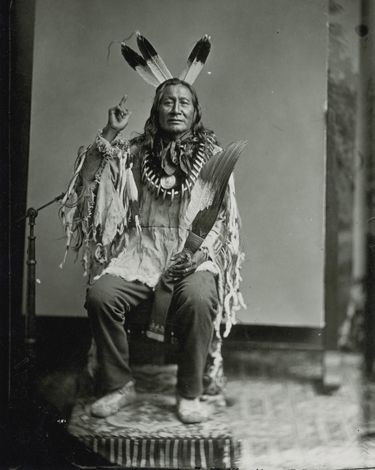 Shown above is an 1880 photograph of Rushing Bear illustrating the sign for “now” (Smithsonian collections).
Shown above is an 1880 photograph of Rushing Bear illustrating the sign for “now” (Smithsonian collections).
What is the current status of Plains Indian Sign Language?
Like most of the native languages of the North American Indians, Plains Indian Sign Language is considered endangered. While there are some elders who are fluent, relatively few children are learning the language. Brenda Farnell writes:
“In the late twentieth century, fluent sign talkers are few, but they can be found in several communities where elders learned the language at an early age, where traditional storytelling keeps it alive, or deafness in a family has preserved its practical functions. Signing remains in use among the Assiniboine, Stoneys, Blackfeet, Piegans, Bloods, Crows, and Northern Cheyennes, in contexts involving such activities as religious ceremonies, drumming, and storytelling.”
In some instances, Plains Indian Sign Language has been incorporated into language-maintenance programs, such as those among the Assiniboine, Blackfoot, Crow, and Northern Cheyenne.
Indians 101/201
Indians 101/201 is a series of essays exploring various topics relating to American Indian histories, cultures, arts, and current concerns. Indians 201 is an expansion of an earlier essay. More from this series:
Indians 101: 500 Years Ago, 1519
Indians 101: Acoma Pueblo and the Spanish, 1539-1599
Indians 101: Some Inuit Carvings (Art Diary)
Indians 101: The Eastern Woodlands Culture Area
Indians 201: Sealth (Seattle), Suquamish/Duwamish Leader
Indians 101: The Ktunaxa Nation (Photo Diary)
Indians 101: Gertrude Simmons Bonnin, Writer, Musician, and Activist
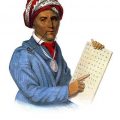
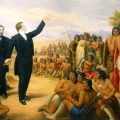
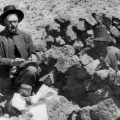
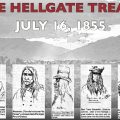
Leave a Reply